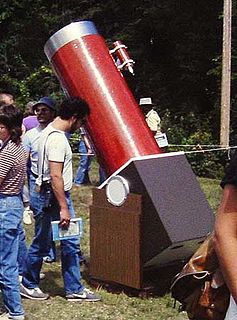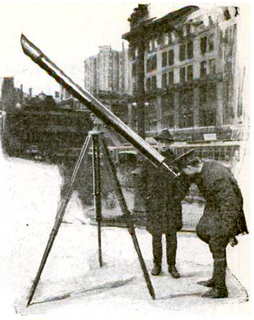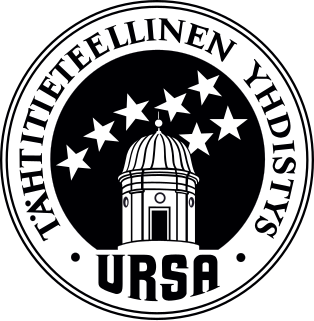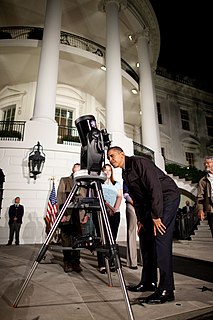This article needs additional citations for verification .(August 2011) |
The Escambia Amateur Astronomers Association (EAAA) is an amateur astronomy club in Northwest Florida.
This article needs additional citations for verification .(August 2011) |
The Escambia Amateur Astronomers Association (EAAA) is an amateur astronomy club in Northwest Florida.
It was originally started in June 1959 by two elementary school students and one about to start junior high school. Originally known as the Warrington Amateur Astronomers Association, the first few years it operated informally as a backyard telescope group. As the membership gained in age, the club was renamed the Escambia Amateur Astronomers Association (EAAA) when the club went county-wide. Activities included star parties, meetings at the public library, and field trips, to the Pensacola Naval Air Station planetarium and centrifuge, to Spring Hill College observatory, to a high school astronomy club 100 miles (160 km) east-in DeFuniak Springs, Florida, The Walton County Astronomy Club. Both were Junior Member Clubs in the Astronomical League. In the 1960s many of the most active members left for college and a new generation of members replaced them. Soon, the club was printing a club newsletter—the "METEOR"—which is still in print. Sponsor Dr. Wayne Wooten edited it for 40 years, and former student Nicole Gunter has taken it over as part of her journalism work at the University of Florida.
The club became inactive in the 1970s. Activity resumed a few years later when the club founder Robert Blake returned to the area as a temporary replacement for the Pensacola Junior College astronomy instructor. He got together such of the old membership as were still in the area in late 1977 and planned a reactivation of the club with the facilities of the community college—such as their Owens Planetarium. With this backing, the club became more and more active. When the astronomy instructor returned, he donated the first large portable telescope to the club—permitting public viewing. Since the 1980s the club hosted a summer viewing program for the National Park Service at the Fort Pickens campground—taken over from a Pensacola Junior College professor Dr. Frank Palma who had previously given the programs. When an annular eclipse took place nearby in May 1984, the club raised the money for safe Mylar solar filter material and then gave programs to schools on how to safely watch the event—with filters handed out at no cost to the students. In 1982, Merry Edenton-Wooten became club president, and her astronomy-related business Draco Productions became the club's sponsor in 1992. She obtained permission from Thomas Baader to purchase and use the new solar filter material, and sell it in a variety of sizes. Draco Productions began making affordable, safe, and superior quality solar filters (endorsed by NASA and the Astronomical League) for naked-eye viewing as well as scope or binocular use with the new Baader solar filter film from the Baader Planetarium in Germany in 1990. Edenton-Wooten has also given many filters to school teachers and students. She believes that making these fine filters, telescopes, and astronomy educational materials available to everyone is her most important contribution to astronomy. For the August 2017 eclipse, Draco and the EAAA provided more than 5000 free safe solar filters to students and the public.
The club's gaze director Dewey Barker has added two other monthly events to the new moon gazes at Fort Pickens. The first quarter moon gazes are held at the Pensacola Beach Pavilion, and third quarter moon gazes at Big lagoon State Park, west of Pensacola. In a typical year, thousands of campers, families, students, and foreign tourists attend EAAA beach gazes. In 2010, EAAA sponsor Dr. Wayne Wooten won the Astronomical League Award for his four decades of helping organize astronomy clubs in Florida and Alabama.
EAAA joined the Astronomical League in the 1960s and has been a member organization continuously—except when the club was inactive. Former EAAA President Merry Edenton-Wooten was the executive secretary of the Astronomical League from 1986–1992, and won its Wright Service Award from the AL in 1991. Sponsor Wayne Wooten won the Astronomical League Award in 2010 for his work promoting amateur astronomy in the South East.
The EAAA has made several attempts to build an observatory, including mounting a dome on top of an Avion travel trailer. But, light pollution made a permanent site impractical so a 16-inch (410 mm) telescope has its own trailer and is taken where needed for public viewing. The EAAA maintains a collection of loaner telescopes for member use for $1 per month rental fee. These now include a 16" Dobsonian, a Meade 16" SCT, a C-11. a Meade 10" SCT, an 8" Dobsonian, two 6" Newtonians, 11x80 binocs, and numerous 4" Newtonians.
Because of the generosity of members in sharing their instruments and time many people have been able to enjoy astronomy opportunities offered to the general public, scouting groups and schools.
In 1982, club president Merry Edenton-Wooten had the idea of using surplus Xerox copier lenses as objectives for beginner scopes. The "copier lens telescope" idea spread across the world, promoted by surplus suppliers like JerryCo and C&H Sales, and led to the construction of thousands of high quality rich field telescopes at very affordable prices.
Like many other astronomy clubs, the EAAA has since 2014 been donating 4" reflectors to local libraries. They have now placed seven of the loaner telescopes for the public to check out and use in Escambia and Santa Rosa county.
The EAAA has enlisted many student members at Pensacola State College and the University of West Florida. Since 2015, they have been involved in a "Galileoscopes for the Eclipse" project. Over 70 of the kits have been built by the students, fitted with safe Baader solar filters from Draco Productions and given to local schools in west Florida and South Alabama.
Escambia Amateur Astronomers Association set up meet dates to study the sky; typically, business meetings are on the Friday closest to the Full Moon for that calendar year.
For a current listing, refer to their Facebook page "Escambia Amateur Astronomers". [1] [2]

An astronomer is a scientist in the field of astronomy who focuses their studies on a specific question or field outside the scope of Earth. They observe astronomical objects such as stars, planets, moons, comets and galaxies – in either observational or theoretical astronomy. Examples of topics or fields astronomers study include planetary science, solar astronomy, the origin or evolution of stars, or the formation of galaxies. Related but distinct subjects like physical cosmology, which studies the Universe as a whole.

John Lowry Dobson was an American amateur astronomer and is best known for the Dobsonian telescope, a portable, low-cost Newtonian reflector telescope. He was also known for his efforts to promote awareness of astronomy through public lectures including his performances of "sidewalk astronomy". Dobson was also the co-founder of the amateur astronomical group, the San Francisco Sidewalk Astronomers.

A Dobsonian telescope is an altazimuth-mounted Newtonian telescope design popularized by John Dobson in 1965 and credited with vastly increasing the size of telescopes available to amateur astronomers. Dobson's telescopes featured a simplified mechanical design that was easy to manufacture from readily available components to create a large, portable, low-cost telescope. The design is optimized for observing faint, deep-sky objects such as nebulae and galaxies. This type of observation requires a large objective diameter of relatively short focal length and portability for travel to less light-polluted locations.

Space Place at Carter Observatory is housed in a historic astronomical observatory located at the top of the Wellington Botanic Garden in Wellington, New Zealand.

Sidewalk astronomy or street corner astronomy refers to the activity of setting up a telescope in an urban place on a for-profit or non-profit basis as entertainment and/or for public education.

Rainwater Observatory and Planetarium is an educational astronomical observatory and Planetarium run as an educational ministry of French Camp Academy. It is located near French Camp, Mississippi, United States. It is the largest observatory in Mississippi with 16+ telescopes, with the largest instruments including a 32-inch Dobsonian telescope and 14-inch Celestron catadioptric telescope. Rainwater is currently awaiting delivery of the Sollee Telescope, a 25-inch research-grade telescope. When installed in the two-story observatory building already constructed in the observatory complex, the Sollee Telescope will be suitable for serious astronomical studies, in the last remaining "dark spot" in Mississippi on the U.S. Dark Skies photograph.

UNA Observatory is an astronomical observatory owned and operated by the University of North Alabama. It is located in Florence, Alabama (USA). It has 2 telescopes, a Celestron 0.35 m Schmidt–Cassegrain telescope. The UNA Planetarium is a 65-seat planetarium with a Spitz A3P projector and East Cost Control Systems controller.

Vega–Bray Observatory is an astronomical observatory owned and operated by Astronomers Inn located on a small hill overlooking the San Pedro River Valley, just east of Benson, Arizona (USA). Founded in 1990 by Max Bray, an optician and Dr. Eduardo Vega, a pathologist, it is home to the Hoot–Vega Radio Telescope.

Fox Observatory is an astronomical observatory owned and operated by South Florida Amateur Astronomers Association. It is located in Sunrise, Florida (US).

The Society for Popular Astronomy (SPA) is a national astronomical society based in the United Kingdom for beginners to amateur astronomy.

The International Year of Astronomy (IYA2009) was a year-long celebration of astronomy that took place in 2009 to coincide with the 400th anniversary of the first recorded astronomical observations with a telescope by Galileo Galilei and the publication of Johannes Kepler's Astronomia nova in the 17th century. The Year was declared by the 62nd General Assembly of the United Nations. A global scheme, laid out by the International Astronomical Union (IAU), was also endorsed by UNESCO, the UN body responsible for educational, scientific, and cultural matters.

The Mills Observatory in Dundee, Scotland, is the first purpose-built public astronomical observatory in the UK. Built in 1935, the observatory is classically styled in sandstone and has a distinctive 7 m dome, which houses a Victorian refracting telescope, a small planetarium, and display areas. The dome is one of two made from papier-mâché to survive in the UK, the other being at the Godlee Observatory.

Ursa Astronomical Association is the largest astronomical association in Finland. Ursa was founded on 2 November 1921. Founding members include a renowned Finnish astronomer Yrjö Väisälä. In 1926 Ursa established the Ursa Observatory in Kaivopuisto district of Helsinki. In 2007 the Tähtikallio Observatory & Education Center was established in Artjärvi, its current equipment includes an Astrofox 36" Folded Newtonian Open tube telescope, an Alluna 16" Ritchey-Chrétien telescope, a Meade 16" LX200GPS Schmidt-Cassegrain telescope, a Sky-Watcher ED 120mm refractor telescope fitted with a Baader AstroSolar Solar Filter and a piggybacked Coronado SolarMax 40 H-Alpha telescope. Ursa's primary functions include advancing amateur astronomy and astronomical education. They have also published a magazine Tähdet ja avaruus since 1971. Anyone can join Ursa for an annual fee.
The Northern Virginia Astronomy Club was founded in 1980 by student amateur astronomers of Thomas Jefferson High School and George Mason University in Northern Virginia near Washington, D.C. with a focus to make astronomy available to the public. It was incorporated in 1991. Monthly meetings are held at 7:00 p.m. at the George Mason University on the second Sunday of each month. Monthly observing sessions, are held at dark sky locations with which the club has prior arrangements.

Astronomical Society Ruđer Bošković is an astronomical society in Belgrade, Serbia. Founded in 1934 by a group of students, it is the oldest one in the Balkans. Initially having only several members, today it gathers more than 700 astronomy lovers. It is named after Ruđer Bošković.
Robert Edward Cox was an American optical engineer and a popularizer of amateur telescope making. He conducted the popular "Gleanings for ATMs" column in Sky and Telescope magazine for 21 years.
The Von Braun Astronomical Society is a society of amateur and professional astronomers dedicated to education and public outreach on behalf of astronomy based in Huntsville, Alabama, United States.

An astronomical filter is a telescope accessory consisting of an optical filter used by amateur astronomers to simply improve the details of celestial objects, either for viewing or for photography. Research astronomers, on the other hand, use various band-pass filters for photometry on telescopes, in order to obtain measurements which reveal objects' astrophysical properties, such as stellar classification and placement of a celestial body on its Wien curve.

Jyotirvidya Parisanstha is an association of amateur astronomers. On August 22, 1944 some eminent citizens of Pune formed JVP, primarily for the spread of knowledge of astronomy among the public and also to make their own contribution as far as possible. It was the first association of its kind and remained so far for a few decades. Right from conception, JVP has been actively working for the propagation of astronomy in purely scientific temperament. JVP is the first Amateur Association to Host the ALL INDIA AMATEUR ASTRONOMERS MEET in 1991 and the first All India Messier Marathon in 2012.

White House Astronomy Night is an event first organized by the White House in conjunction with the Office of Science and Technology Policy to motivate interest in astronomy and science education. The original White House Astronomy Night was held in 2009 on the South Lawn. In 2010 the White House and the Office of Science and Technology Policy organized a similar event with help from Hofstra University, this time held on the National Mall. Between 2010 and 2014 annual events took place at the National Mall with coordination between Hofstra University and federal agencies including: the Smithsonian National Air and Space Museum, NASA, and the National Science Foundation. In 2015 an event took place in June at the National Mall, and then back at the White House again on October 19.